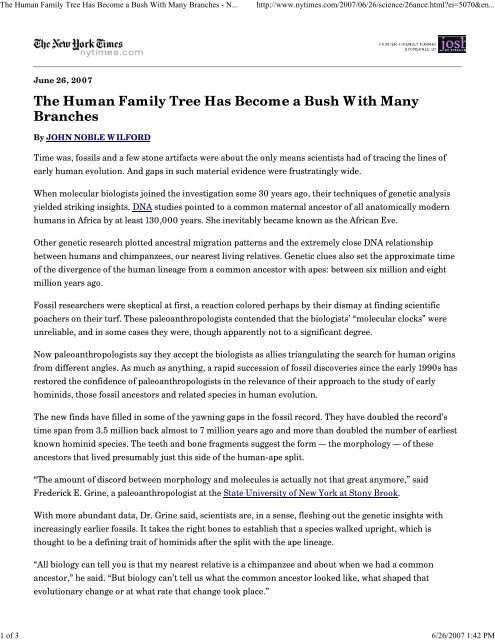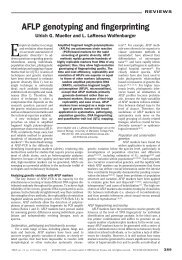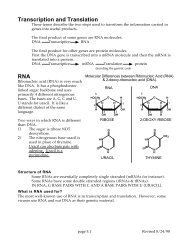The Human Family Tree Has Become a Bush With Many Branches - ...
The Human Family Tree Has Become a Bush With Many Branches - ...
The Human Family Tree Has Become a Bush With Many Branches - ...
You also want an ePaper? Increase the reach of your titles
YUMPU automatically turns print PDFs into web optimized ePapers that Google loves.
<strong>The</strong> <strong>Human</strong> <strong>Family</strong> <strong>Tree</strong> <strong>Has</strong> <strong>Become</strong> a <strong>Bush</strong> <strong>With</strong> <strong>Many</strong> <strong>Branches</strong> - N...<br />
http://www.nytimes.com/2007/06/26/science/26ance.html?ei=5070&en...<br />
1 of 3 6/26/2007 1:42 PM<br />
June 26, 2007<br />
<strong>The</strong> <strong>Human</strong> <strong>Family</strong> <strong>Tree</strong> <strong>Has</strong> <strong>Become</strong> a <strong>Bush</strong> <strong>With</strong> <strong>Many</strong><br />
<strong>Branches</strong><br />
By JOHN NOBLE WILFORD<br />
Time was, fossils and a few stone artifacts were about the only means scientists had of tracing the lines of<br />
early human evolution. And gaps in such material evidence were frustratingly wide.<br />
When molecular biologists joined the investigation some 30 years ago, their techniques of genetic analysis<br />
yielded striking insights. DNA studies pointed to a common maternal ancestor of all anatomically modern<br />
humans in Africa by at least 130,000 years. She inevitably became known as the African Eve.<br />
Other genetic research plotted ancestral migration patterns and the extremely close DNA relationship<br />
between humans and chimpanzees, our nearest living relatives. Genetic clues also set the approximate time<br />
of the divergence of the human lineage from a common ancestor with apes: between six million and eight<br />
million years ago.<br />
Fossil researchers were skeptical at first, a reaction colored perhaps by their dismay at finding scientific<br />
poachers on their turf. <strong>The</strong>se paleoanthropologists contended that the biologists’ “molecular clocks” were<br />
unreliable, and in some cases they were, though apparently not to a significant degree.<br />
Now paleoanthropologists say they accept the biologists as allies triangulating the search for human origins<br />
from different angles. As much as anything, a rapid succession of fossil discoveries since the early 1990s has<br />
restored the confidence of paleoanthropologists in the relevance of their approach to the study of early<br />
hominids, those fossil ancestors and related species in human evolution.<br />
<strong>The</strong> new finds have filled in some of the yawning gaps in the fossil record. <strong>The</strong>y have doubled the record’s<br />
time span from 3.5 million back almost to 7 million years ago and more than doubled the number of earliest<br />
known hominid species. <strong>The</strong> teeth and bone fragments suggest the form — the morphology — of these<br />
ancestors that lived presumably just this side of the human-ape split.<br />
“<strong>The</strong> amount of discord between morphology and molecules is actually not that great anymore,” said<br />
Frederick E. Grine, a paleoanthropologist at the State University of New York at Stony Brook.<br />
<strong>With</strong> more abundant data, Dr. Grine said, scientists are, in a sense, fleshing out the genetic insights with<br />
increasingly earlier fossils. It takes the right bones to establish that a species walked upright, which is<br />
thought to be a defining trait of hominids after the split with the ape lineage.<br />
“All biology can tell you is that my nearest relative is a chimpanzee and about when we had a common<br />
ancestor,” he said. “But biology can’t tell us what the common ancestor looked like, what shaped that<br />
evolutionary change or at what rate that change took place.”
<strong>The</strong> <strong>Human</strong> <strong>Family</strong> <strong>Tree</strong> <strong>Has</strong> <strong>Become</strong> a <strong>Bush</strong> <strong>With</strong> <strong>Many</strong> <strong>Branches</strong> - N...<br />
http://www.nytimes.com/2007/06/26/science/26ance.html?ei=5070&en...<br />
2 of 3 6/26/2007 1:42 PM<br />
Although hominid species were much more apelike in their earliest forms, Tim D. White of the University of<br />
California, Berkeley, said: “We’ve come to appreciate that you cannot simply extrapolate from the modern<br />
chimp to get a picture of the last common ancestor. <strong>Human</strong>s and chimps have been changing down through<br />
time.”<br />
But Dr. White, one of the most experienced hominid hunters, credits the genetic data with giving<br />
paleoanthropologists a temporal framework for their research. <strong>The</strong>ir eyes are always fixed on a time horizon<br />
for hominid origins, which now appears to be at least seven million years ago.<br />
Ever since its discovery in 1973, the species Australopithecus afarensis, personified by the famous Lucy<br />
skeleton, has been the continental divide in the exploration of hominid evolution. Donald Johanson, the<br />
Lucy discoverer, and Dr. White determined that the apelike individual lived 3.2 million years ago, walked<br />
upright and was probably a direct human ancestor. Other afarensis specimens and some evocative footprints<br />
showed the species existed for almost a million years, down to three million years ago.<br />
In the 1990s, scientists finally crossed the Lucy divide. In Kenya, Meave G. Leakey of the celebrated<br />
fossil-hunting family came up with Australopithecus anamensis, which lived about four million years ago<br />
and appeared to be an afarensis precursor. Another discovery by Dr. Leakey challenged the prevailing view<br />
that the family tree had a more or less single trunk rising from ape roots to a pinnacle occupied by Homo<br />
sapiens. Yet here was evidence that the new species Kenyanthropus platyops co-existed with Lucy’s afarensis<br />
kin.<br />
<strong>The</strong> family tree now looks more like a bush with many branches. “Just because there’s only one human<br />
species around now doesn’t mean it was always that way,” Dr. Grine said.<br />
Few hominid fossils have turned up from the three-million- to two-million-year period, during which<br />
hominids began making stone tools. <strong>The</strong> first Homo species enter the fossil record sometime before two<br />
million years ago, and the transition to much larger brains began with Homo erectus, about 1.7 million years<br />
ago.<br />
Other recent discoveries have pushed deeper in time, closer to the hominid origins predicted by molecular<br />
biologists.<br />
Dr. White was involved in excavations in Ethiopia of many specimens that lived 4.4 million years ago and<br />
were more primitive and apelike than Lucy. <strong>The</strong> species was named Ardipithecus ramidus. Later, a related<br />
species from 5.2 million to 5.8 million years ago was classified Ardipithecus kadabba.<br />
At that time, six years ago, C. Owen Lovejoy of Kent State University said, “We are indeed coming very close<br />
to that point in the fossil record where we simply will not be able to distinguish ancestral hominid from<br />
ancestral” chimpanzees, because, he said, “<strong>The</strong>y were so anatomically similar.”<br />
Two even earlier specimens are even harder to interpret. One found in Kenya by a French team has been<br />
dated to six million years and named Orrorin tugenensis. <strong>The</strong> teeth and bone pieces are few, though the<br />
discoverers think a thigh fragment suggests that the individual was a biped — a walker on two legs.<br />
Another French group then uncovered 6.7-million-year-old fossils in Chad. Named Sahelanthropus
<strong>The</strong> <strong>Human</strong> <strong>Family</strong> <strong>Tree</strong> <strong>Has</strong> <strong>Become</strong> a <strong>Bush</strong> <strong>With</strong> <strong>Many</strong> <strong>Branches</strong> - N...<br />
http://www.nytimes.com/2007/06/26/science/26ance.html?ei=5070&en...<br />
3 of 3 6/26/2007 1:42 PM<br />
tchadensis, the sole specimen includes only a few teeth, a jawbone and a crushed cranium. Scientists said<br />
the head appeared to have perched atop a biped.<br />
“<strong>The</strong>se are clearly the earliest hominids we have,” said Eric Delson, a human-origins scientist at the<br />
American Museum of Natural History. “But we still know rather little about any of these specimens. <strong>The</strong><br />
farther back we go toward the divergence point, the more similar specimens will look on both sides of the<br />
split.”<br />
Other challenges arise from human evolution in more recent epochs. Just who were the “little people” found<br />
a few years ago in a cave on the island of Flores in Indonesia? <strong>The</strong> Australian and Indonesian discoverers<br />
concluded that one partial skeleton and other bones belonged to a now-extinct separate human species,<br />
Homo floresiensis, which lived as recently as 18,000 years ago.<br />
<strong>The</strong> apparent diminutive stature and braincase of the species prompted howls of dispute. Critics contended<br />
that this was not a distinct species, but just another dwarf-size Homo sapiens, possibly with a brain disorder.<br />
Several prominent scientists, however, support the new-species designation.<br />
<strong>The</strong> tempest over the Indonesian find is nothing new in a field known for controversy. Some scholars<br />
counsel patience, recalling that it was years after the discovery of the first Neanderthal skull, in 1856, before<br />
it was accepted as an ancient branch of the human family. Critics had at first dismissed the find as only the<br />
skull of a degenerate modern human or a Cossack who died in the Napoleonic wars.<br />
Perhaps the analogy is not as encouraging as intended. Scientists to this day are arguing about<br />
Neanderthals, their exact relationship to us and the cause of their extinction 30,000 years ago, not long after<br />
the arrival in Europe of the sole surviving hominid that is so curious about its origins.<br />
Copyright 2007 <strong>The</strong> New York Times Company<br />
Privacy Policy Search Corrections RSS First Look Help Contact Us Work for Us Site Map
















